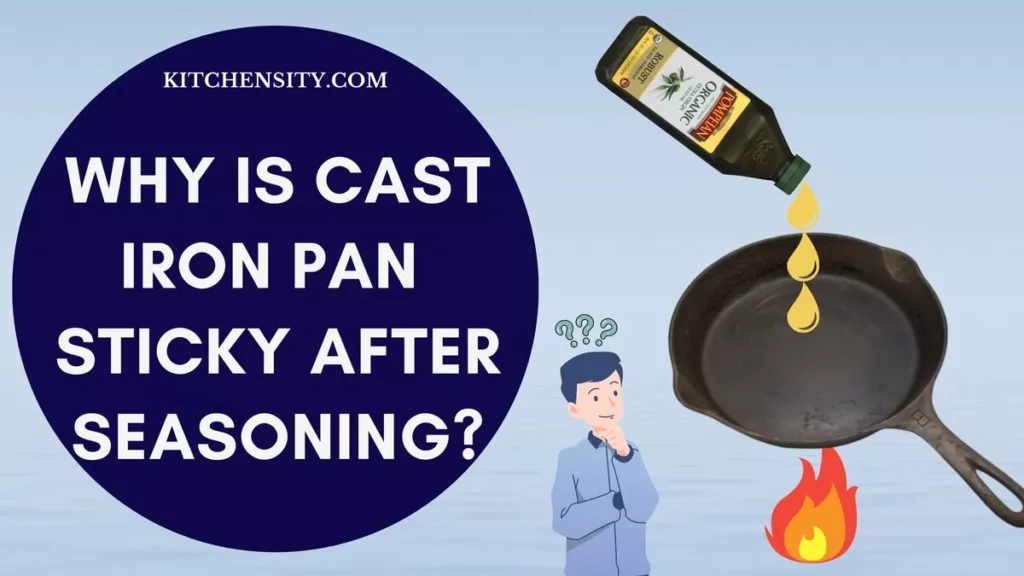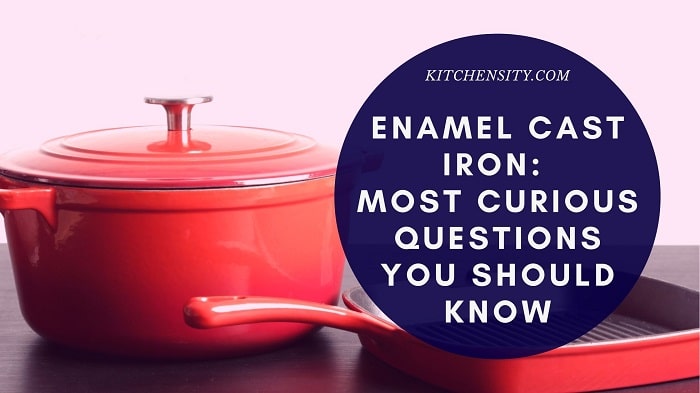Cast iron pans are prized for their durability and ability to retain heat, making them a favorite among professional chefs and home cooks alike.
However, one common issue that many people encounter with cast iron pans is stickiness, even after seasoning.
In this article, we will explore the reasons behind this sticky residue and discuss some effective ways to prevent and resolve this problem.
Whether you’re a seasoned cast iron enthusiast or a beginner, understanding the causes of stickiness can help you maintain and enjoy your cast iron cookware for years to come.

Table of Contents
- 1 Why Is Cast Iron Pan Sticky After Seasoning?
- 2 Understanding Seasoning
- 3 Common Causes Of Stickiness Of Cast Iron Pan
- 4 How To Fix Sticky Cast Iron Skillet?
- 5 How To Prevent Stickiness Of Cast Iron Skillet?
- 6 Why Does My Cast Iron Look Weird After Seasoning?
- 7 How Do You Tell If A Cast Iron Pan Is Seasoned Properly?
- 8 Should Cast Iron Be Shiny After Seasoning?
- 9 What Does Over-Seasoned Cast Iron Look Like?
- 10 Can You Ruin The Seasoning On A Cast Iron Skillet?
- 11 Final Verdict
- 12 You May Also Like
- 13 FAQs
Why Is Cast Iron Pan Sticky After Seasoning?
A cast iron pan can become sticky after seasoning due to factors such as excess oil, inadequate polymerization, and trapped moisture. These issues can prevent the formation of a smooth, non-stick surface. Proper seasoning techniques, controlled heat during cooking, and regular maintenance can prevent stickiness.
Read below for detailed reasons.
Also Read – Seasoned Vs Unseasoned Cast Iron Skillet
Understanding Seasoning
Before delving into why a cast iron pan may become sticky after seasoning, it is essential to understand what seasoning is.
- Seasoning refers to the process of coating the cast iron pan’s surface with a layer of polymerized oil. This layer creates a natural non-stick surface and prevents rusting.
- The seasoning process involves applying a thin layer of oil to the pan and then heating it to a high temperature, allowing the oil to bond with the pan’s surface.
Common Causes Of Stickiness Of Cast Iron Pan
Although seasoning is intended to create a smooth and non-stick surface, cast iron pans can occasionally become sticky. Several factors can contribute to this issue, including excess oil, polymerization issues, and moisture trapped in the seasoning layer.
Also Read – Why Do Cast Iron Pans Crack?
1. Excess Oil
Excess oil during the seasoning process is a common cause of stickiness in a cast iron pan. When too much oil is applied, it can create a thick layer that fails to fully polymerize.
This means that the oil doesn’t undergo the desired chemical reaction to form a hard, durable surface. Instead, it remains sticky and doesn’t provide the smooth non-stick properties that a properly seasoned cast iron pan should have.
The stickiness caused by excess oil can be problematic in several ways.
- Firstly, when you touch the pan, you may feel a tacky or sticky residue on its surface.
- This can be unpleasant and make it difficult to handle the pan comfortably.
- Additionally, when cooking, food has a higher tendency to stick to the surface of the pan.
- This can result in difficulties flipping or removing food from the pan, and it may require scraping or scrubbing to clean the stuck-on residue.
To prevent the issue of excess oil and stickiness, it is crucial to apply the right amount of oil during the seasoning process. It’s important to note that the goal is to create a thin and even layer of oil that will polymerize effectively.
Using too much oil not only leads to stickiness but also hinders the polymerization process, as the excess oil takes longer to dry and harden.
Also Read – How To Clean A Cast Iron Grill Pan?
2. Polymerization Issues
Polymerization issues can also contribute to the stickiness of a cast iron pan after seasoning.
Polymerization refers to the chemical reaction that occurs when the oil applied to the pan’s surface transforms into a solid, protective layer. This layer is what gives the cast iron pan its non-stick properties and helps prevent rusting.
If the oil is not given sufficient time to polymerize, the resulting layer may not fully solidify and can remain sticky. Similarly, if the seasoning process is not carried out at the optimal temperature, the polymerization reaction may not occur as effectively, leading to stickiness.
- To ensure proper polymerization, it’s important to follow the recommended guidelines for seasoning a cast iron pan.
- This typically involves applying a thin layer of oil to the pan’s surface and heating it at a specific temperature.
- The heating process allows the oil to undergo the polymerization reaction, forming a hard and durable layer.
It’s crucial to give the oil enough time to bond with the pan’s surface and polymerize properly. Rushing the process or not allowing sufficient heating time can result in an insufficiently polymerized layer, leading to stickiness.
- Moreover, the temperature at which the seasoning process is carried out plays a significant role in the polymerization reaction.
- Different oils have different smoke points, which is the temperature at which the oil starts to break down and emit smoke.
- It’s important to use an oil with a high smoke point and ensure that the pan is heated to a temperature that allows for effective polymerization without reaching the oil’s smoke point.
- If the temperature is too low, the oil may not fully polymerize, resulting in a sticky surface.
To prevent polymerization issues and stickiness, it’s crucial to follow the recommended seasoning techniques and temperatures.
Allow sufficient time for the oil to bond and solidify, and ensure that the heating temperature is appropriate for the specific oil being used.
By doing so, you can achieve a properly polymerized surface that enhances the non-stick properties of your cast iron pan.
Also Read – Cast Iron Skillet Gift Basket Ideas
3. Moisture Trapped In Seasoning
Moisture trapped in the seasoning layer of a cast iron pan can be another factor that contributes to stickiness. If the pan is not completely dried before applying the oil for seasoning, any residual moisture can become trapped within the layer.
- When moisture is present during the seasoning process, it can hinder the proper polymerization of the oil.
- As the pan heats up, the moisture turns into steam, creating pockets or bubbles within the seasoning layer.
- These trapped pockets of moisture can prevent the oil from fully bonding with the surface of the pan and forming a smooth, non-stick coating.
Over time, the trapped moisture can lead to stickiness on the surface of the cast iron pan. This stickiness can make it difficult to cook and clean, as food tends to adhere to the pan, and the residue can be challenging to remove.
Additionally, if moisture remains trapped within the seasoning layer for extended periods, it can contribute to the development of rust, further compromising the pan’s performance and longevity.
- To prevent moisture-related stickiness in a cast iron pan, it is essential to ensure that the pan is thoroughly dried before applying the oil for seasoning.
- After cleaning the pan, use a clean cloth or paper towel to absorb any remaining moisture.
- You can also place the pan on a stovetop or in a warm oven for a short period to evaporate any residual moisture completely.
Also Read – Can You Use Olive Oil To Season Cast Iron Pans?
How To Fix Sticky Cast Iron Skillet?
If you have a sticky cast iron pan, there are several methods you can try to fix the issue and restore its non-stick properties. Here are some steps you can take:
- Stripping And Re-seasoning:
- One effective method is to strip the pan down to its bare metal and re-season it.
- This process involves removing the old seasoning by scrubbing the pan with steel wool or using an oven cleaner.
- Once the pan is stripped, it can be thoroughly dried, re-oiled, and seasoned following the proper techniques.
- This method allows you to start fresh with a clean surface and create a new, well-bonded seasoning layer.
- Applying High Heat:
- Another approach is to apply high heat to the pan.
- This can help burn off any excess oil or moisture trapped within the seasoning layer.
- Place the pan in an oven set at a high temperature, typically around 400-450°F (200-230°C), for about an hour.
- This high heat can encourage the polymerization of the oil and eliminate stickiness.
- Remember to take precautions when handling the hot pan.
- Utilizing Cooking Oils:
- Choosing the right cooking oils can also play a role in fixing stickiness.
- Oils with high smoke points, such as vegetable oil or flaxseed oil, are recommended for seasoning cast iron pans.
- Applying a thin layer of oil and then heating the pan at medium-high heat can help re-bond and re-polymerize the oil, improving the non-stick properties.
- Repeat this process several times, allowing the oil to heat and polymerize with each application.
Remember, fixing a sticky cast iron pan may require some trial and error, and it’s essential to be patient throughout the process. It’s also crucial to maintain proper cleaning and seasoning practices after fixing the stickiness to prevent the issue from recurring.
If the stickiness persists despite your efforts, it may be helpful to seek advice from seasoned cast iron enthusiasts or refer to reputable online resources for additional troubleshooting tips.
Taking the time to fix a sticky cast iron pan can be worthwhile, as it restores its functionality and allows you to enjoy the benefits of cooking with a well-seasoned and non-stick surface once again.
You can watch this video for more information.
Also Read – Is It Safe To Cook In A Rusty Cast Iron Pan?
How To Prevent Stickiness Of Cast Iron Skillet?
Prevention is key when it comes to avoiding stickiness in your cast iron pan. By following some essential practices, you can ensure a smooth and non-stick surface.
1. Proper Cleaning Techniques
Proper cleaning techniques play a crucial role in maintaining the seasoning of a cast iron pan and preventing stickiness.
It’s important to avoid using harsh soaps or abrasive scrubbers that can strip away the protective seasoning layer. Instead, opt for gentle cleaning methods that preserve the integrity of the seasoning while effectively removing food residue.
Here are the proper cleaning techniques for maintaining a cast iron pan:
- Rinse the pan with hot water immediately after use.
- Avoid using harsh soaps or abrasive scrubbers.
- Use a soft brush or sponge for gentle scrubbing.
- Create a paste with coarse salt and water to remove stubborn food residues.
- Rinse the pan thoroughly with hot water.
- Avoid using soap, as it can strip away the seasoning.
- Dry the pan completely with a clean cloth or paper towel.
- Place the pan on a stovetop or in a warm oven to ensure thorough drying.
- Apply a thin layer of oil after cleaning to protect the seasoning.
Also Read – Why Griswold Cast Iron Is So Expensive?
2. Controlled Heat And Temperature
Controlled heat and temperature are crucial when cooking with a cast iron pan to prevent stickiness and preserve the seasoning. Improper heat management can lead to the breakdown of the seasoning layer and result in a sticky surface.
To maintain the integrity of the seasoning, it is important to follow these guidelines:
- Preheating:
- Before adding any ingredients, preheat the cast iron pan gradually and at a lower temperature.
- This allows the pan to evenly distribute the heat and ensures that the seasoning is not exposed to sudden extreme temperatures.
- Start with low to medium heat and gradually increase it as needed.
- Even Heat Distribution:
- Cast iron pans have excellent heat retention properties, but they can also develop hot spots if not properly heated.
- To ensure even heat distribution, allow the pan to preheat for a few minutes on low to medium heat before adding any ingredients.
- This will help the heat spread evenly across the cooking surface and minimize the risk of sticky spots.
- Avoid Rapid Temperature Changes:
- Rapid temperature changes can cause the seasoning to contract and expand quickly, leading to the breakdown of the protective layer.
- For example, pouring cold ingredients onto a hot cast iron pan or transferring the pan directly from high heat to a cold surface can result in stickiness.
- To prevent this, allow the pan to cool down gradually before cleaning or storing it.
- Moderate Heat Levels:
- Excessive heat can also compromise the seasoning of a cast iron pan.
- High heat can cause the oil in the seasoning to burn or polymerize too quickly, resulting in a sticky surface.
- It is generally recommended to cook on medium to medium-high heat with a cast iron pan, as it provides a good balance between heat retention and preventing stickiness.
Also Read – Is Enameled Cast Iron Cookware Safe?
3. Regular Maintenance
Regular maintenance is key to ensuring the longevity of your cast iron pan and preventing stickiness. Here are some guidelines for regular maintenance:
- Cleaning:
- After each use, it is important to clean the cast iron pan following the proper cleaning techniques mentioned earlier.
- This includes rinsing with hot water, using a gentle brush or sponge for scrubbing, and avoiding harsh soaps or abrasive scrubbers that can strip away the seasoning.
- Regular cleaning helps remove any food residues and prevents the buildup of sticky substances.
- Drying:
- Thoroughly drying the cast iron pan after cleaning is crucial to prevent moisture-related issues and stickiness.
- After rinsing, use a clean cloth or paper towels to absorb any excess water.
- To ensure complete drying, place the pan on a stovetop or in a warm oven for a few minutes.
- Proper drying prevents moisture from accumulating and causing stickiness or rust.
- Oil Application:
- Applying a thin layer of oil to the pan’s surface after cleaning helps maintain the seasoning and prevent stickiness.
- The oil replenishes any oil that may have been removed during the cleaning process and acts as a protective barrier.
- Simply pour a small amount of oil onto the pan and use a paper towel or cloth to spread it evenly across the surface, including the bottom and sides.
- This helps maintain the non-stick properties and prevents the development of sticky residue.
Regular maintenance ensures that the cast iron pan remains in optimal condition and minimizes the risk of stickiness.
Also Read – Do You Need To Season Enameled Cast Iron?
Why Does My Cast Iron Look Weird After Seasoning?
If your cast iron pan looks weird or unusual after seasoning, it can be disconcerting. Here are some possible reasons why your cast iron may have an odd appearance after seasoning:
- Uneven Seasoning:
- Uneven seasoning can result in patches or areas of the pan looking different.
- This can happen if the oil was not evenly distributed or if certain areas received more oil during the seasoning process.
- The uneven distribution of oil can cause variations in the color and texture of the seasoning layer.
- Excessive Oil:
- Using too much oil during the seasoning process can lead to a thick and uneven layer.
- This excessive oil may not have fully polymerized or dried properly, resulting in an unusual appearance.
- It can create a blotchy or sticky surface that looks different from a smooth, well-seasoned pan.
- Polymerization Issues:
- If the oil did not undergo proper polymerization, it can affect the appearance of the seasoning.
- Polymerization is the chemical reaction that forms the protective layer on the cast iron surface.
- If the oil was not given enough time to polymerize or if the seasoning process was not carried out at the optimal temperature, the resulting layer may look strange and may not provide the desired non-stick properties.
- Residual Residue:
- If there were any residues or impurities on the pan before seasoning, they can affect the appearance of the seasoning layer.
- These residues may not bond well with the oil during the seasoning process and can create unusual spots or discoloration.
If your cast iron pan looks weird after seasoning, here are a few steps you can take:
- Assess The Seasoning: Examine the appearance of the pan and identify any areas that look unusual or different. Determine if it is a cosmetic issue or if it affects the functionality of the pan.
- Re-Season: If the appearance is primarily cosmetic and does not affect the pan’s performance, you may choose to continue using the pan as is. Over time and with regular use, the seasoning may even out and improve.
- Strip And Re-Season:
- If the appearance significantly affects the pan’s functionality or if you prefer a more uniform look, you can consider stripping the pan down to its bare metal and re-seasoning it.
- This process involves removing the existing seasoning and starting fresh.
- Follow proper seasoning techniques and ensure even distribution of oil to achieve a more uniform appearance.
Remember that the appearance of the seasoning does not necessarily indicate a problem with the pan’s functionality. As long as the pan remains well-seasoned and provides a non-stick surface, it can still be used effectively for cooking.
Also Read – Can You Use Enameled Cast Iron On A Glass Cooktop?
How Do You Tell If A Cast Iron Pan Is Seasoned Properly?
Determining if a cast iron pan is seasoned properly can be done by observing its appearance, texture, and performance. Here are some indicators to look for:
- Smooth And Shiny Surface:
- A well-seasoned cast iron pan should have a smooth and shiny surface.
- The seasoning layer should appear even and uniform across the entire cooking surface, including the bottom and sides of the pan.
- The smoothness indicates that the oil has polymerized and formed a protective layer.
- Non-Stick Properties:
- A properly seasoned cast iron pan will exhibit excellent non-stick properties.
- When cooking, food should release easily from the surface without sticking or leaving behind excessive residue.
- You should be able to flip and move food effortlessly in the pan.
- Darkened Color:
- Seasoning gives the cast iron pan a darkened color.
- Over time, with multiple layers of seasoning, the pan may develop a deeper black or brown hue.
- This darkened color is a result of the oil bonding with the iron and forming the seasoning layer.
- Lack Of Rust Or Corrosion:
- A well-seasoned pan is resistant to rust and corrosion.
- Proper seasoning creates a barrier that protects cast iron from moisture and prevents rust from developing.
- If your cast iron pan is adequately seasoned, you should not see any signs of rust or corrosion on its surface.
- Ease Of Cleaning:
- Cleaning a well-seasoned cast iron pan should be relatively easy.
- After use, food residue should be minimal and should easily come off with gentle scrubbing using hot water.
- The seasoning layer should not wash off or show signs of degradation during the cleaning process.
It’s important to note that the seasoning of a cast iron pan develops and improves over time with repeated use and proper maintenance.
If you are unsure whether your pan is seasoned properly, you can continue to use it regularly and observe how it performs. With each use, the seasoning layer will continue to build and enhance the pan’s non-stick properties.
Also Read – Can You Put Enamel Cast Iron In The Dishwasher?
Should Cast Iron Be Shiny After Seasoning?
After seasoning, a cast iron pan may have a shiny appearance, but it is not necessarily a requirement. The level of shine can vary depending on factors such as the type of oil used, the number of seasoning layers, and the cooking habits of the user.
When a cast iron pan is properly seasoned, it forms a polymerized layer of oil on its surface. This layer provides non-stick properties and helps protect the pan from rust. The appearance of the seasoning layer can range from matte to slightly shiny or even glossy.
Some people prefer a shiny appearance, which can be achieved by using oils with higher smoke points, such as flaxseed oil, and applying multiple thin layers of seasoning.
The repeated application of oil and heat can create a smoother, more polished surface with a shinier appearance.
However, it’s important to note that the shine of the seasoning does not necessarily correlate with its effectiveness or non-stick properties. A well-seasoned cast iron pan can perform excellently, whether it has a shiny or slightly matte appearance.
The key indicators of proper seasoning are the pan’s non-stick properties, the absence of rust or corrosion, and the ease of cleaning.
As long as the pan has a smooth, well-bonded seasoning layer that provides a non-stick surface and protects against rust, the level of shine is a matter of personal preference and does not affect the pan’s functionality.
Also Read – How To Season And Clean Cast Iron Cookware?
What Does Over-Seasoned Cast Iron Look Like?
Over-seasoned cast iron can have several visual indicators that distinguish it from properly seasoned cast iron. Here are some signs of over-seasoned cast iron:
- Sticky Or Tacky Surface:
- One common sign of over-seasoning is a sticky or tacky feeling on the pan’s surface.
- The seasoning layer may not have fully dried or polymerized, resulting in a sticky residue that can transfer to food and make it difficult to cook or clean.
- Thick And Uneven Coating:
- Over-seasoning can lead to a thick and uneven layer of seasoning on the cast iron pan.
- Instead of a smooth and thin coating, the excess oil can accumulate and create a lumpy or uneven surface.
- This can affect the pan’s non-stick properties and make cooking more challenging.
- Splotchy Appearance:
- Over-seasoned cast iron may exhibit a splotchy or blotchy appearance.
- The excessive oil may not have evenly distributed or bonded with the pan’s surface, resulting in patches of darker or lighter areas.
- This uneven seasoning can affect both the visual appearance and the cooking performance of the pan.
- Excessive Flaking Or Peeling:
- When a cast iron pan is over-seasoned, the seasoning layer may start to flake or peel off.
- This can occur due to the buildup of too many layers of seasoning, causing them to become brittle or unstable.
- The flaking or peeling seasoning can result in an inconsistent and unreliable non-stick surface.
- Smoking Or Burning:
- Over-seasoning can lead to excessive smoking or burning when the pan is heated.
- The excess oil can burn and create a strong smoke or unpleasant smell.
- This can be an indication that there is too much oil on the pan’s surface and the seasoning needs to be adjusted.
If you observe any of these signs of over-seasoning, it may be necessary to address the issue. Stripping the pan down to its bare metal and re-seasoning it following proper techniques can help restore the pan’s functionality and non-stick properties.
Remember that finding the right balance of seasoning is essential for optimal performance and enjoyment of your cast iron cookware.
Also Read – Can You Use Vinegar On Enameled Cast Iron?
Can You Ruin The Seasoning On A Cast Iron Skillet?
Yes, it is possible to ruin the seasoning on a cast iron skillet. The seasoning layer on a cast iron skillet can be compromised or damaged through various factors. Here are some ways in which the seasoning can be ruined:
- Using Harsh Cleaning Methods:
- Using harsh soaps, abrasive cleaners, or scouring pads can strip away the seasoning layer.
- These cleaning methods can be too aggressive and remove the oil that forms the protective coating on the skillet’s surface.
- Scrubbing With Metal Utensils:
- Scrubbing the cast iron skillet with metal utensils, such as metal spatulas or forks, can cause scratches or gouges on the seasoning layer.
- These scratches can create spots where the seasoning is weakened or removed, leading to uneven and compromised protection.
- Exposing To High Heat Or Rapid Temperature Changes:
- Subjecting the cast iron skillet to extreme temperatures, such as placing a cold skillet on a hot stovetop or exposing it to high heat for an extended period, can damage the seasoning.
- Rapid temperature changes can cause the seasoning to expand and contract abruptly, leading to cracks or flakes.
- Leaving Moisture On The Surface:
- Allowing moisture to sit on the surface of the cast iron skillet for an extended period can lead to rust formation, which can deteriorate the seasoning layer.
- Proper drying after cleaning is crucial to prevent moisture-related damage.
- Neglecting Regular Maintenance:
- Failing to maintain the seasoning layer through regular cleaning and re-oiling can result in its degradation over time.
- Without proper upkeep, the seasoning can become thin, patchy, or worn out, making it less effective in providing a non-stick surface and rust protection.
While the seasoning on a cast iron skillet can be ruined, it’s important to note that it can also be restored through re-seasoning. By stripping the skillet down to the bare metal and following proper seasoning techniques, a new layer of seasoning can be established.
Taking care to avoid the actions mentioned above and maintaining regular cleaning and seasoning practices can help preserve the seasoning on a cast iron skillet and extend its lifespan.
With proper care, a well-seasoned cast iron skillet can provide years of reliable non-stick performance and durability.
Also Read – Can You Put Enameled Cast Iron In The Oven?
Final Verdict
In conclusion, a cast iron pan can become sticky after seasoning due to various factors. Excess oil during the seasoning process, inadequate polymerization of the oil, and trapped moisture can all contribute to stickiness.
It’s important to apply the right amount of oil, allow sufficient time for proper polymerization, and ensure thorough drying before seasoning.
- Proper cleaning techniques, such as avoiding harsh soaps and abrasive scrubbers, and thorough drying after cleaning, are essential for maintaining the seasoning and preventing stickiness.
- Controlled heat and temperature during cooking helps preserve the seasoning layer and prevent breakdown or stickiness.
- Regular maintenance, including regular cleaning, drying, and oil application, is key to keeping the cast iron pan in optimal condition and preventing stickiness.
- Additionally, being mindful of signs of over-seasoning and addressing them promptly can help maintain the pan’s functionality.
While a sticky cast iron pan may be frustrating, it can often be remedied by adjusting the seasoning or re-seasoning the pan.
With proper care and attention to seasoning techniques, a well-maintained cast iron pan can provide excellent cooking performance, a non-stick surface, and long-lasting durability.
You May Also Like
- Does Enamel Cast Iron Chip?
- How To Clean A Cast Iron Grill Pan?
- Why Does Food Stick To My Enamel Cast Iron?
- Best Enameled Cast Iron Cookware Sets
FAQs
-
Can I Use Soap To Clean A Cast Iron Pan?
No, it is best to avoid using soap when cleaning a cast iron pan as it can strip away the seasoning. Hot water and a gentle brush or sponge are sufficient for regular cleaning.
-
How Often Should I Season My Cast Iron Pan?
The frequency of seasoning depends on how frequently you use your cast iron pan. As a general guideline, it is recommended to season your pan every few months or when you notice a decline in its non-stick properties.
-
Can I Use A Dishwasher To Clean A Cast Iron Pan?
No, dishwashers can be too harsh and can damage the seasoning of a cast iron pan. Hand washing is the preferred method for cleaning and maintaining its non-stick surface.
-
Why Does Food Stick To My Cast Iron Pan Even After Seasoning?
Food sticking to a cast iron pan can be caused by various factors, such as inadequate seasoning, improper cooking techniques, or not using enough oil or fat while cooking. Ensuring proper seasoning and using enough oil can help alleviate this issue.
-
Can I Use Metal Utensils With A Cast Iron Pan?
It is best to avoid using metal utensils with a cast iron pan as they can scratch the seasoning. Instead, opt for wooden, silicone, or other non-metal utensils to preserve the pan’s non-stick surface.
Katrina Smith is a seasoned expert with over 25 years of experience in all things related to cooking and the kitchen. As an avid cook and kitchen enthusiast, she is passionate about sharing her knowledge and expertise on cookware, kitchen appliances, kitchen tips, and kitchen staples.
Through her articles and reviews, Katrina aims to inspire and help others improve their cooking skills, experiment with different ingredients, and invest in quality cookware and appliances.

![How To Season And Clean Cast Iron Cookware? [4 Effective Ways] 3 How To Season And Clean Cast Iron Cookware](https://www.kitchensity.com/wp-content/uploads/2020/06/How-To-Season-And-Clean-Cast-Iron-Cookware.jpg)





